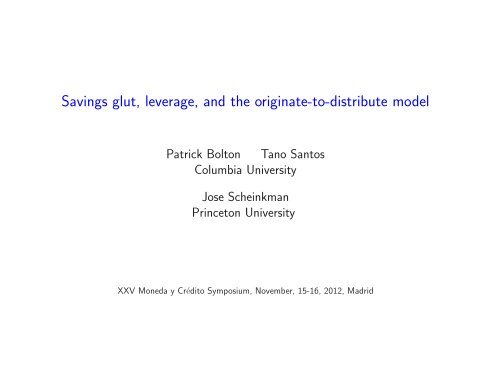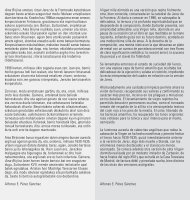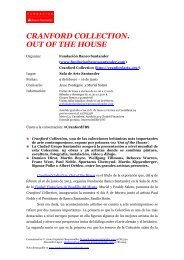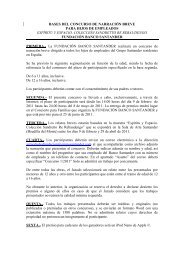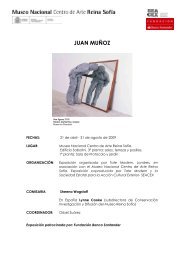Savings glut, leverage, and the originate-to-distribute model
Savings glut, leverage, and the originate-to-distribute model
Savings glut, leverage, and the originate-to-distribute model
Create successful ePaper yourself
Turn your PDF publications into a flip-book with our unique Google optimized e-Paper software.
Motivation <strong>and</strong> introduction• The years leading up <strong>to</strong> <strong>the</strong> crisis were characterized by several features:I. Progressive deterioration of mortgage underwriting st<strong>and</strong>ardsII. Price compressions in tranches of different qualities, at least judging by <strong>the</strong> 2006 vintage ABXindex.III. Increase <strong>leverage</strong> among broker dealers driven <strong>to</strong> some extent by <strong>the</strong> increase in repo transactionswhere <strong>the</strong> counterparties are agents such as money market funds.• There are some narratives trying <strong>to</strong> make sense of <strong>the</strong>se disparate facts but few, if any, formaltreatments.• Here we focus on a particular source of variation: The growth of cash pools in <strong>the</strong> h<strong>and</strong>s ofinves<strong>to</strong>rs seeking deposit-like instruments, safe <strong>and</strong> liquid <strong>and</strong> that <strong>the</strong> traditional banking systemcannot supply.– Institutional cash pools: Corporates <strong>and</strong> mutual funs cash positions, securities lenders, ...• Animportantcharacteristicof<strong>the</strong>sepoolsisthat,inprinciple, <strong>the</strong>yarenotbundledwithknowledgeabout, say, real estate risk: Growth of “uninformed funds”
Prices: ABX for 2006 <strong>and</strong> 2007-1 for AAA <strong>and</strong> BBB debt. Source: Markit
• Here we propose a simple <strong>model</strong> where <strong>the</strong> exogenous source of variation is precisely <strong>the</strong> growthof funds in <strong>the</strong> h<strong>and</strong>s of uninformed inves<strong>to</strong>rs.– We have nothing <strong>to</strong> say about <strong>the</strong> origins of this growth.• The <strong>model</strong> has three ingredients:I. Endogenous origination quality: A moral hazard problem at origination that results in a particulardistribution if risk qualityII. Rich market structure: Flows across different markets of funds <strong>and</strong> risks(A) “Uninformed exchange,” where uninformed inves<strong>to</strong>rs acquire risk assets.– Key feature: Cash-in-<strong>the</strong>-market pricing(B) “Private market,” where informed inves<strong>to</strong>rs operate <strong>and</strong> cream skim <strong>the</strong> best assets.(C) Markets for secured lending, where some of <strong>the</strong> funds in <strong>the</strong> h<strong>and</strong>s of uninformed inves<strong>to</strong>rsflow <strong>to</strong> informed inves<strong>to</strong>rs through <strong>leverage</strong>.III. Endogenous information acquisition: The amount of capital bundled with knowledge is endogenous.
• In our <strong>model</strong> <strong>the</strong> growth of uninformed funds:I. Produces a narrowing of <strong>the</strong> price spreads across markets due <strong>to</strong> cash-in-<strong>the</strong>-market pricingII. This lowers <strong>the</strong> returns associated with <strong>the</strong> uninformed exchangeIII. As a result some of <strong>the</strong> funds “spill over” <strong>to</strong> o<strong>the</strong>r markets:(A) Capital in private markets: Some of <strong>the</strong>se funds become bundled with knowledge <strong>and</strong>finance informed transactions in capital markets(B) Repo transactions: Ano<strong>the</strong>r fraction of <strong>the</strong>se funds flow in<strong>to</strong> markets for secured lendingincreasing <strong>the</strong> <strong>leverage</strong> of informed inves<strong>to</strong>rsIV. Incentives for origination of good assets are non-mo<strong>to</strong>ne in <strong>the</strong> size of <strong>the</strong> funds of uninformedinves<strong>to</strong>rs:(A) Incentives increase with informed capital(B) Incentives decrease as price spreads narrow
A simple <strong>model</strong>I. Timing: Three dates t = 0,1,2• t = 0, origination <strong>and</strong> capital distribution across markets• t = 1, distribution of <strong>originate</strong>d assets• t = 2 payoffs are realized.
II. Agents(A) Origina<strong>to</strong>rs• There is a unit measure of origina<strong>to</strong>rs, agents in charge of funding assets in <strong>the</strong> economy.• We assume that each origina<strong>to</strong>r can generate one <strong>and</strong> only one project, which can be abusiness or consumer loan, a mortgage, or any o<strong>the</strong>r asset.• The quality of <strong>the</strong> asset can be high or low:– An origina<strong>to</strong>r can ei<strong>the</strong>r <strong>originate</strong> a high quality asset that pays x h at t = 2 with probabilitye or a low quality asset that pays x l < x h , with probability 1−e.• The probability e is a costly decision: Entrepreneurs bear a private cost ψ(e) of choosing alevel of effort e ∈ (0,1).– ψ(0) = 0 <strong>and</strong> ψ e > 0 <strong>and</strong> ψ ee ≥ 0.– The quality of <strong>the</strong> projects is independent across origina<strong>to</strong>rs.
(B) Financial intermediaries• There is a measure ι of risk neutral financial intermediaries.• Each intermediary i ∈ [0,ι] is endowed with one unit of capital <strong>and</strong> a technology <strong>to</strong> acquireinformation given by ϕ(i) with ϕ(0) ≥ 0 <strong>and</strong> ϕ i > 0.• These intermediaries provide liquidity <strong>to</strong> <strong>the</strong> entrepreneurs at <strong>the</strong> interim stage <strong>and</strong> <strong>the</strong>ycan do so, as we will see, in ei<strong>the</strong>r a public exchange or a private market.– It is access <strong>to</strong> this private market that entails incurring <strong>the</strong> cost ϕ(i). Finally intermediariesonly consume at date t = 2.
III. Markets(A) Private markets• An intermediary i ∈ [0,ι] gains access <strong>to</strong> this market by paying <strong>the</strong> cost ϕ(i)• Informed intermediaries supply liquidity cream skimming <strong>the</strong> best assets, those that pay x h .• Price in this market p d : As in Bol<strong>to</strong>n, San<strong>to</strong>s <strong>and</strong> Scheinkman (2012)where p is <strong>the</strong> price in <strong>the</strong> exchange.p d = κx h +(1−κ)p, (1)• n: Number of good assets acquired by each of <strong>the</strong> intermediaries in <strong>the</strong> private market.• Origina<strong>to</strong>rs distributing asset in this market for a price p d get matched <strong>to</strong> one informedintermediary with probabilitym = in(2)πe• After cream skimming, <strong>the</strong> supply of assets available <strong>to</strong> uninformed inves<strong>to</strong>rs isS = π(1−em) (3)
(B) Public markets or exchanges• Uninformed intermediaries acquire risks in <strong>the</strong> exchange• The quantity of good <strong>and</strong> bad projects flowing in<strong>to</strong> <strong>the</strong> uninformed exchange is given byS h = πe(1−m) <strong>and</strong> S l = π(1−e). (4)• The expected payoff of <strong>the</strong> assets traded in <strong>the</strong> exchange is given byp max (i,e,n) = S hx h +S l x lS(5)
• Cash-in-<strong>the</strong>-market pricing:– The cash available <strong>to</strong> absorb asset sales in <strong>the</strong> uninformed exchange isι−(1+l)i (6)where l is <strong>the</strong> amount borrowed by each of <strong>the</strong> informed intermediaries.– As we have seen <strong>the</strong> <strong>to</strong>tal number of projects flowing <strong>to</strong> <strong>the</strong> exchange is givenπ(1−em)– Cash-in-<strong>the</strong>-market prices, p cim , may obtain <strong>and</strong> that <strong>the</strong> price in <strong>the</strong> exchange isp cim = ι−(1+l)iπ(1−em)(7)• Thus <strong>the</strong> equilibrium price in <strong>the</strong> exchange is:p = min{p cim ,p max} (8)
(C) Markets for secured lending• Intermediaries present in <strong>the</strong> uninformed exchange can led <strong>to</strong> those in private markets.• Intermediaries present in private markets borrow from those present in exchanges against<strong>the</strong> asset acquired <strong>to</strong> finance <strong>the</strong> purchase itself.• l <strong>the</strong> amount borrowed by each of <strong>the</strong> intermediaries present in private markets. Leverageconstraint is:(1−η)np ≥ l, with η ∈ (0,1) (9)• The balance sheet of <strong>the</strong> intermediaries in private markets is:np d = 1+l. (10)• Combining <strong>the</strong>se two expressions:l = (1−η)pp d −(1−η)p<strong>and</strong> n =1p d −(1−η)p(11)
Payoffs <strong>and</strong> definition of equilibriumI. Payoffs(A) Origina<strong>to</strong>rs: Choice variable: eU e (e|i) = −ψ(e)+π [ emp d +(1−em)p ] +(1−π)(ex h +(1−e)x l ) (12)(B) Financial intermediaries: Choice variables: Whe<strong>the</strong>r <strong>to</strong> become informed <strong>and</strong>, if so, l <strong>and</strong> n.V ( ĩ ) =⎧⎪⎨⎪⎩r−ϕ ( ĩ ) +R+l(R−r)if ĩ ≤ iif ĩ > i(13)II. Definition of equilibrium• An equilibrium is a measure of intermediaries present in private markets, i ∗ , an equilibriumeffort action, e ∗ , a <strong>leverage</strong> ratio, l ∗ , number of good assets bought by each intermediarypresent in private markets, n ∗ , prices p d∗ , p ∗ , (<strong>and</strong> thus returns R ∗ <strong>and</strong> interest rates r ∗ ) suchthat agents maximize <strong>and</strong> markets clear.
The effect of <strong>the</strong> pool of uninformed funds, ι, on <strong>the</strong> measure of informed capital i ∗• The condition that determines <strong>the</strong> marginal intermediary that is indifferent between trading in <strong>the</strong>exchange or in <strong>the</strong> private market:r ∗ = −ϕ(i ∗ )+R ∗ +l ∗ (R ∗ −r ∗ ) (14)• We are interested in∂l∂i∂ι = ∂ι (R−r)+(1+l) ∂ ∂ι (R−r)ϕ i• Given that ϕ i > 0 <strong>and</strong> that under some conditions∂l∂ι > 0 <strong>and</strong> ∂∂ι (R−r),an increase in an uninformed funds increases <strong>the</strong> amount of informed capital.
The effect of <strong>the</strong> pool of uninformed funds, ι, on originations incentives, e ∗• Consider <strong>the</strong> first order condition for effort:ψ e = πm ( p d −p ) +(1−π)(x h −x l ) (15)• Then <strong>the</strong> effort as a function of <strong>the</strong> measure of intermediaries ι is such thate ι = ∂e∂ι ∝ m (ι p d −p ) +m ( p d )ι −p ι(16)ψ ee• Under simple conditions one can show thatm ∗ ι> 0 <strong>and</strong> pd∗ ι −p ∗ ι < 0• Thus <strong>the</strong> increase in <strong>the</strong> size of <strong>the</strong> funds of uninformed inves<strong>to</strong>rs has an ambiguous effect on <strong>the</strong>incentives <strong>to</strong> <strong>originate</strong> good assets.
Example• Consider <strong>the</strong> following parametric assumptions– First,π = 1 η = .5 κ = .1,– The effort function is given byψ(e) = θ 2 e2 with θ = .01– The costs of becoming informed are given by• π = 1: ”Originate-<strong>and</strong>-<strong>distribute</strong>” economyϕ(i) = .05+βi for i ∈ [0,ι] with β = 1.75• We characterize this economy as a function of <strong>the</strong> measure of intermediaries ι ∈ [.2,1].
0.050.0450.040.035Measure of intermediaries in private markets, i ∗0.030.0250.020.0150.010.00500.2 0.3 0.4 0.5 0.6 0.7 0.8 0.9 1Measure of intermediaries, ιFigure 1: Measure of intermediaries present in private markets, i ∗ as a function of <strong>the</strong> measure of intermediaries, ι• As <strong>the</strong> measure of uninformed intermediaries increase, more of those with better informationacquisition technologies migrate <strong>to</strong> private markets.• That is, more capital flows in<strong>to</strong> private market transactions.
0.350.30.25Matching probability, m ∗0.20.150.10.0500.2 0.3 0.4 0.5 0.6 0.7 0.8 0.9 1Measure of intermediaries, ιFigure 2: Matching probability, m ∗ as a function of <strong>the</strong> measure of intermediaries, ι• As a result <strong>the</strong> fraction of good risks funded with informed capital increases.– As a result m ∗ is an increasing function of ι.• This results in an improvement on incentives: as ⇑ m ∗⇒ ⇑ e ∗
0.10.090.08Spread in prices between private markets <strong>and</strong> exchanges0.070.060.050.040.030.020.010.2 0.3 0.4 0.5 0.6 0.7 0.8 0.9 1Measure of intermediaries, ιFigure 3: Price spread, p d∗ −p ∗ , as a function of <strong>the</strong> measure of intermediaries, ι• But <strong>the</strong> increase in <strong>the</strong> funds available <strong>to</strong> absorb risk in <strong>the</strong> exchange pushes prices, p ∗ upwards<strong>and</strong> closes <strong>the</strong> spread between <strong>the</strong> informed <strong>and</strong> <strong>the</strong> uninformed price:– ⇑ ι ⇒ ⇓ p d∗ −p ∗• This effect decreases incentives for good origination. What is <strong>the</strong> net effect?
0.40.350.30.25effort level, e *0.20.150.10.0500.2 0.3 0.4 0.5 0.6 0.7 0.8 0.9 1Measure of intermediaries, ιFigure 4: Equilibrium level of effort, e ∗ as a function of <strong>the</strong> measure of intermediaries, ι• In <strong>the</strong> absence of informed capital <strong>the</strong>re are no incentives for good origination, i ∗ = 0• After a certain threshold <strong>the</strong> most efficient intermediaries start acquiring information <strong>and</strong> creamskimming <strong>the</strong> good projects: ⇑ m ∗– This results in an improvement of origination incentives <strong>and</strong> so ⇑ e ∗• Eventually <strong>the</strong> price spread effect“catches up” <strong>and</strong> <strong>the</strong>n origination incentives start go down: ⇓ e ∗
1.81.71.6Rates of return in private markets <strong>and</strong> interest rates1.51.41.31.21.110.65 0.7 0.75 0.8 0.85 0.9 0.95 1Measure of intermediaries, ιFigure 5: Rates in private markets, R ∗ (dashed), <strong>and</strong> interest rates r ∗ as a function of <strong>the</strong> measure of intermediaries, ι• The rates move in opposite direction <strong>to</strong> <strong>the</strong> measure of of intermediaries.• The spread though increases: The rate in private markets R ∗ drops at a slower rate than <strong>the</strong> riskfree rate r ∗ .• This results in an increase in <strong>leverage</strong>.
10.90.80.70.6Leverage, l ∗0.50.40.30.20.100.2 0.3 0.4 0.5 0.6 0.7 0.8 0.9 1Measure of intermediaries, ιFigure 6: Equilibrium level of <strong>leverage</strong>, l ∗ as a function of <strong>the</strong> measure of intermediaries, ι• Leverage is obviously 0 when agents are not present in private markets <strong>and</strong> only lever up, l ∗ > 0whenever i ∗ > 0.
• Conclusion:– An increase in <strong>the</strong> funds of uninformed inves<strong>to</strong>rs:I. Increases uninformed prices <strong>and</strong> depresses price spreadsII. pushing efficient intermediaries <strong>to</strong> private marketsIII. which first increases incentives for origination but, eventually, incentives deteriorate.IV. Simultaneously interest rates drop <strong>and</strong> repo transactions, as well as <strong>leverage</strong>, increase.– Thus <strong>the</strong> <strong>model</strong> can help rationalize several features of <strong>the</strong> data apparent in <strong>the</strong> last cycle.– The question though still remains: Origins of <strong>the</strong> savings <strong>glut</strong>?


